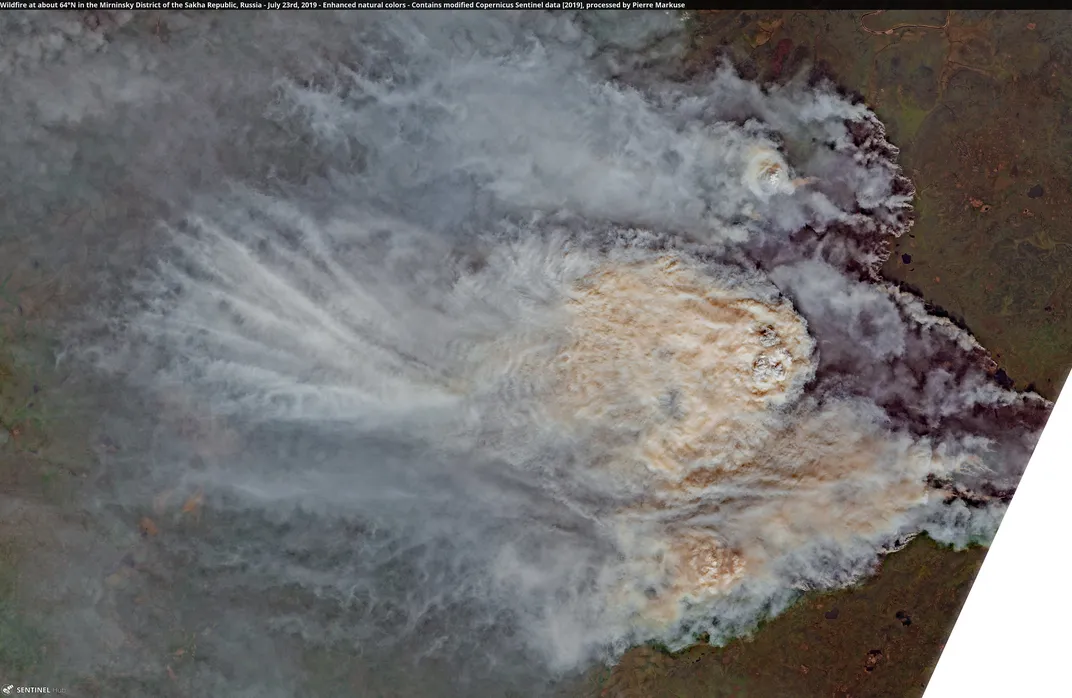The Arctic Is Experiencing Its Worst Wildfire Season on Record
Arctic infernos released 50 megatons of carbon dioxide—the equivalent of Sweden’s total annual emissions—into the atmosphere in June alone
/https://tf-cmsv2-smithsonianmag-media.s3.amazonaws.com/filer/5b/91/5b911fe7-4cfb-42d9-ba59-22f86dff15c3/screen_shot_2019-07-29_at_110347_am.png)
The Arctic Circle is in the midst of an "unprecedented" wildfire season on record, with more than 100 blazes raging across the region since the start of June.
As Mark Parrington, senior scientist at the Copernicus Atmosphere Monitoring Service (CAMS), tells CNN’s Isabelle Gerretsen, the scale and intensity of these recent wildfires is “unusual and unprecedented.”
Still, Parrington adds in a CAMS press release, “Temperatures in the Arctic have been increasing at a much faster rate than the global average, and warmer conditions encourage fires to grow and persist once they have been ignited.”
Per the World Meteorological Organization (WMO), June 2019 was Earth’s warmest June on record. Due in large part to this heat surge, wildfires are now running rampant in Siberia, Greenland, Alaska and Canada, producing plumes of smoke visible from space.
Morgan Hines of USA Today reports that experts use satellite imagery to capture hot spots indicative of peat fires, which burn far longer than normal forest fires. Wired’s Matt Simon further explains that peat, made up of decomposing organic matter such as moss, hardens into coal when enough pressure is applied. In healthy ecosystems, water-heavy peatland can actually prevent the spread of wildfires, but when peat dries up, as is the case in much of the warming Arctic, it becomes highly flammable.
As Thomas Smith, an environmental geographer at the London School of Economics, says to Hines, peat fires act much like cigarettes, smoldering for months at a time.
“The fires are burning through long-term carbon stores, … emitting greenhouse gases, which will further exacerbate greenhouse warming, leading to more fires,” Smith notes.

According to the CAMS statement, Arctic infernos released 50 megatons of carbon dioxide—the equivalent of Sweden’s total annual emissions—into the atmosphere in June alone. This amount represents more than was emitted by Arctic fires in the same month between 2010 to 2018 combined.
Although much of the affected region is sparsely populated, the scientists point out that wind can spread wildfire pollution thousands of miles from its source, covering more populous areas in shrouds of smoke. On Twitter last week, atmospheric scientist Santiago Gassó estimated that Siberian fires had created a smoke lid extending over 4.5 million square kilometers, or roughly 1.7 million square miles, of central and northern Asia.
For the Guardian, Edward Helmore reports that 11 out of 49 Russian regions are currently experiencing wildfires. In Alaska, blazes have burned through an estimated 2.06 million acres, while in Greenland, the still-raging Sisimiut blaze has arrived close on the heels of an unusually early ice sheet melting season.
CNN’s Gerretsen points out that climate change-induced heatwaves trigger Arctic wildfires, which in turn contribute to climate change by releasing carbon dioxide and pollutants into the atmosphere.
As the WMO’s Claudia Volosciuk tells CNN, “When particles of smoke land on snow and ice, [they] cause the ice to absorb sunlight that it would otherwise reflect, and thereby accelerate the warming in the Arctic.”
Unfortunately, Smith explains to USA Today's Hines, firefighters have little recourse for extinguishing blazes in inaccessible parts of the Siberian Arctic. Here, the only force capable of putting out fires is rain.
The news is slightly more positive in Alaska, where first responders can reach fires that break out further south, but as Matt Simon concludes for Wired, “Meanwhile, the Arctic is burning” with few signs of faltering anytime soon.
/https://tf-cmsv2-smithsonianmag-media.s3.amazonaws.com/accounts/headshot/mellon.png)
/https://tf-cmsv2-smithsonianmag-media.s3.amazonaws.com/accounts/headshot/mellon.png)